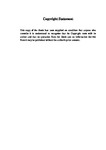An Empirical Study into UK Customer Expectations of Dining Out in Relation to Meal Cost
| dc.contributor.supervisor | Brunt, Paul | |
| dc.contributor.author | Westhead, Christina | |
| dc.contributor.other | Plymouth Business School | en_US |
| dc.date.accessioned | 2013-10-02T08:44:38Z | |
| dc.date.available | 2013-10-02T08:44:38Z | |
| dc.date.issued | 2012 | |
| dc.identifier | 721079 | en_US |
| dc.identifier.uri | http://hdl.handle.net/10026.1/1963 | |
| dc.description.abstract |
The continued growth of the UK dining out industry, and the unceasing trend in popularity for customers to spend time and money eating outside the home, has led to an increase in the number of dining out establishments, and competition between businesses. Although there have been studies examining aspects of the restaurant industry and food consumption outside the home, very little research has looked specifically at customer expectations. Therefore, this thesis examines customer expectations associated with the meal experience in relation to the varying costs of dining out opportunities. In addition, the study reflects on customers’ socio-economic characteristics combined with their perception of differing anticipated costs in order to provide customer typologies, each with varying expectations of the dining out experience. It is intended that by focussing on and amalgamating the areas of expectation, cost and socio-economic factors, the conclusions obtained will contribute to a new understanding relating to customer expectations. The study invited e-subscribers of Delicious Magazine’s national website, to participate in quantitative research regarding both expectations of dining out and social factors. By examining the data from a large cohort study (2200 participants) evidence of behavioural patterns and opinions has emerged. The research established that there are four types of customer that can be identified through their initial choice of restaurant owing to the restaurant’s perceived cost classification. Each customer group identified, not only has overarching expectations of the dining out experience, but through identifying socio-economic characteristics of each group, it is also possible to have insight into their collective behaviours. The original contribution outputs that have been generated from the research are a practical typology and a theoretical model. Although dining out establishments are facing pressure from the emergence of increasing numbers of competitors and the current economic climate, it has been established, through the research, that, in particular, restaurants often bestow little attention on customer requirements, instead ‘food’, ‘aesthetics’ and ‘staff’ often take precedence. However, aspects relating directly to customers, such as, ‘repeat business’ and ‘positive word of mouth’ are core components to a hospitality organisation’s success. Understanding customers further can only enhance and provide structure and direction for restaurant businesses. Therefore, implementing the practical customer typology could focus a restaurant business on considering their customer group and their anticipated requirements. This research is a foundation into an original combined study area and has induced further research concepts that may also encourage other academics to embark on this area of study. This research may then develop as a subject field and cascade into understandings that could be beneficial to the hospitality industry. | en_US |
| dc.language.iso | en | en_US |
| dc.publisher | University of Plymouth | en_US |
| dc.subject | Hospitality | en_US |
| dc.subject | Restaurants | |
| dc.subject | Customer Expectations | |
| dc.subject | Meal cost | |
| dc.subject | Socio-economics | |
| dc.title | An Empirical Study into UK Customer Expectations of Dining Out in Relation to Meal Cost | en_US |
| dc.type | Thesis | |
| dc.identifier.doi | http://dx.doi.org/10.24382/4031 | |
| dc.identifier.doi | http://dx.doi.org/10.24382/4031 |
Files in this item
This item appears in the following Collection(s)
-
01 Research Theses Main Collection
Research Theses Main


